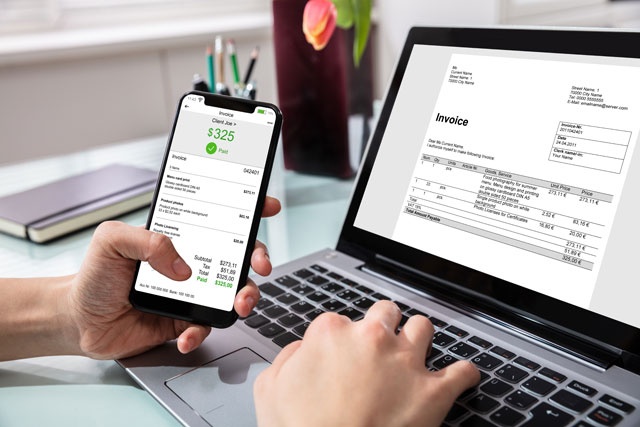Before we begin to discuss how the PC connects to the Internet, or even begin to cover the definition of the Internet, we should familiarize ourselves with the history and evolution of the computer. Many of today's electronic devices, such as handheld cell phones, contain the computing power of devices that used to require more storage than a small warehouse. In fact, a small processor in today's computers that measures much less than an inch in length contains more power than the first computer ever developed, a system called the Electronic Numerical Integrator and Computer (ENIAC), which required more than 600 square feet of space. ENIAC's development was achieved in secret and completed in 1946, when it was presented to the world at the University of Pennsylvania. The work was performed in secret mainly because the notion of a computer was a very foreign concept to people in 1946. Even in today's modern, technologically-advanced world, there are people who harbor some fear and skepticism about computers and machines.
Although it is somewhat difficult to point to a single person as the inventor of the computer, most experts agree that Alan Turing, an English mathematician, was the most influential person in laying the groundwork for what would become the modern-day personal computer. His work in mathematics, chemistry, and logic helped to create, among many other things, programming languages, which we will cover in more detail later in this chapter. Without a programming language, a computer would not know how to work. It is to a computer what the brain is to a human body.
Innovative companies like IBM, Apple, and Commodore, among many others, built upon the work of Alan Turing and the team of scientists who built ENIAC to bring us what is known today as the personal computer, so named because it can now be used by millions of people and can fit in your lap. The first personal computer was developed in 1977 by a company called Commodore, which would, several years later, release a computer called the Commodore 64 that would become the best-selling single computer model ever invented. The 64 in its name was a reference to its memory capacity, which is a measure of how much information a computer can store and process. The 64 was short for 64 kilobytes, with a kilobyte measuring approximately 1,000 bytes of information. So in 1982, when the Commodore 64 was released, 64,000 bytes of memory was considered cutting-edge. By comparison, most computers sold in 2010 will contain an average of six billion bytes of memory.
Specifications and Terms
Network
When ENIAC was first invented, it was, naturally, the only computer in the entire world. By 1977, however, with the release of the first personal computer, there were thousands of computers throughout the United States alone that were being used by individuals and businesses. Each individual could use his or her computer to draft a letter, analyze data, and even play games. But, as the personal computer evolved, it became evident that communication between two computers had enormous potential to dramatically change the way people and businesses communicated with one another. The infrastructure to connect two or more computers is called a network. By about 1982, there were many networks in operation throughout the world, and most of them were Local Area Networks (LANs), which connected two or more computers to one another that usually were housed in the same building or room. By contrast, Wide Area Networks (WANs) would later connect computers over a greater distance, across cities or even across the country through the use of telephone lines.
Modem
In a WAN, two or more computers are connected across a great distance. A modem is a device that connects to a computer (or is contained within it) that enables data to be transferred over a telephone line or a cable television wire. The use of telephone lines to transmit data is becoming quite outdated. Today it is far more common to connect computers through the use of cable wires, and this connection is referred to as a "broadband" connection.
Internet
Now that we have a solid understanding of networks and modems, we can discuss the Internet. The Internet is a collection of networks. Just as a WAN connects two computers that might be on opposite ends of a city, the Internet connects all the networks of the world so that one computer on a network can interact with another computer (or a series of computers) that is contained on a separate network. The Internet is often described as a global system of networks. It has given us the ability to transfer data in seconds – even milliseconds – to computers across the globe.
Bytes, Kilobytes, Megabytes, Gigabytes…and so on!
When we discuss the transfer of data from one computer to another, we measure this transfer in bytes. A byte is a unit of information. When we refer to the speed of a car, we measure it in miles per hour; a mile is a measurement of space. Similarly, a byte is a measurement of data that is being stored or transferred. A byte is an extremely small amount of data and, as technology has evolved, it has become necessary to discuss bytes in much larger quantities. If you are discussing the size of a document on a computer, for example, you might refer to its size in kilobytes, with one kilobyte equal to approximately 1,000 bytes. (Kilo denotes a thousand; in computer technology a kilobyte is not exactly 1,000 bytes, but it is very close.) So a document on your computer, often referred to as a file, such as a resume might contain, for example, 70 kilobytes of data. That means it contains approximately 70,000 bytes. As a matter of comparison, the Commodore 64, which as we discussed was the biggest selling single computer model ever sold, was able to hold only 64,000 bytes of information. As technology evolves, we are able to store and process staggering amounts of data; hence the need for terms such as megabytes and gigabytes. A megabyte is approximately one million bytes, and a gigabyte is approximately one billion bytes. And, within the last few years, we have even begun using the term terabyte, which is a collection of approximately one trillion bytes of information.
Random Access Memory (RAM) and Processors
As an Internet specialist, you may often be asked one of the most popular questions of people who are in the marketplace for a new computer: "What do all those statistics mean, and what do I need to look for when buying one?" This is a big question, and we could spend an entire book alone in discussing each statistic, but we will cover some of the most fundamental ones here. One of the most important characteristics of a computer is how much memory it has. Memory should not be confused with storage space, which we will discuss next. In simple terms, you may think of memory as a measurement of how much information a computer can process in a single moment. A processor is a device in a computer (similar to a human being's brain) that controls all the functions of a computer. The speed of a processor will determine, for example, how quickly your computer will process data and how quickly it can produce images in your favorite computer game. It is, just as a brain, controlling millions of pieces of data every moment. The amount of space, or the amount of data, that a processor has in order to control a computer is called its Random Access Memory (RAM), and the amount of RAM can have an effect on how fast a computer can operate. A typical computer sold today might have a RAM capacity of six billion bytes of information, which means its processor has six billion units of storage in order to process information.
Hard Drive or Data Storage
The hard drive of a computer is simply its storage capacity. When you save a file on your computer, or when you install a computer game, you are storing that file on a computer's hard drive. Do not confuse a computer's "memory" space with its hard drive space. A typical computer sold today might have a hard drive capable of holding 500 gigabytes of data – there are even some that can hold terabytes, or trillions of bytes of data. In recent years, computer manufacturers have been building hard drives capable of holding staggering amounts of data.
Programming Languages
When humans speak to one another, we obviously use a language, whether it is spoken or expressed in sign language.A language is a series of sounds or gestures that enables us to communicate. Computers have their own series of languages. A computer programmer will type a series of commands in a specific language, and when the computer reads this language, it will process all of its specified commands. For example, a programmer might type a series of commands that instruct the computer to open a document. This might seem like a very simple task because all you do is press a button to do so, but a computer must be told exactly what to do. A programmer uses programming languages to issue these commands.
Operating Systems
Internet Addresses and Domain Names
One of the most important concepts to understand about the Internet is how Internet addresses, or domain names, work. We will discuss specific types of software that people use to access the Internet in more detail later, but we must briefly discuss Internet browsers here before we examine Internet addresses in detail. While in the early days of the Internet there were very few choices for browsers, there are now quite a few companies that have developed commercially successful browsers. Internet Explorer, developed by Microsoft, has been a favorite choice for many millions of people around the world for several decades now. The browser that you choose depends on your personal tastes and needs. Regardless of which browser you choose, however, they all deliver one fundamental service: They enable people to type in an Internet address, and they process this address by opening the requested Web site. For example, to open Google's very popular search, you would type its Internet address, www.google.com, in an Internet browser. Almost immediately, the Web site opens in the browser, but, like so many things relating to computers and technology, there are many processes occurring behind the scenes to make that happen. We will examine some of these processes here.
When people type an Internet address in a browser, they usually are typing the name of a company. Examples are www.ABCNews.com, www.Google.com, or www.UniversalClass.com. Each of these addresses will open the company's Web site and transfer data from the server to your computer. A server is a specific type of computer that contains data and waits for other computers (often called "clients") to request this data. But, when someone enters www.google.com in an Internet browser, the browser must convert this name into an actual Internet address that other computers can understand. This happens instantaneously behind the scenes by using the Domain Name System (DNS).
Domain Name System (DNS)
The DNS is a database of names and their respective IP addresses. Every single time someone types an address in an Internet browser, a request goes to the DNS, resulting in billions each day. It is a remarkable system maintained by literally millions of people. When you build a new Web site, for example, a designer will register your name with the DNS, or if you move your site from one Internet service provider (ISP) to another, your new company will update your DNS entry. These types of changes occur millions of times a day, making the DNS one of the largest and most updated databases in the world.
Let us take a closer look at domain names. Here is a list of some very popular Web sites and their domain names:
- Google.com
- ABCNews.com
- Yahoo.com
- Harvard.edu
- IRS.gov
- BBCNews.co.uk
The second portion of all of the preceding examples (".com," ".edu," ".uk," etc.) is called a top-level domain. There are several hundred top-level domains, with ".com" being the most well-known. Educational institutions use the top-level domain of "edu," governments use "gov," and there is a two-digit top-level domain for every country in the world, as in the above example for BBC News' site in the United Kingdom. The two-letter domain for the United States is, as you might expect, "us." Many American companies use the popular ".com" top-level domain, but it is also very common to see addresses such as www.state.pa.us, which is the address for the Commonwealth of Pennsylvania's Web site.
The left portion of the above examples is called the second-level domain. In google.com, "Google" is the second-level domain. Used together, the second-level domain "google" and the top-level domain ".com" uniquely identify Google's servers.
A domain name must be unique to a specific computer. For example, www.microsoft.com is entirely separate from www.microsoft.org. If a domain name could point to more than one computer, there would be utter chaos on the Internet. When you type a domain name in an Internet browser, the DNS can determine exactly which computer in the world you are referencing. A company called Network Solutions is responsible for ensuring that duplicate domain names are not registered.
One piece of advice that many Internet specialists and Web designers give their clients is to register all top-level domains after they have chosen their name. In other words, if your company's name is Willy Wonka's Chocolate Factory, you will want to register all of the following domains: willywonka.com, willywonka.net, and willywonka.org. The reasoning behind this practice is so that your company will have complete control over your company's image on the Internet. If, for example, you did not register willywonka.net, someone – anyone in the world – may do so. They could, for example, create a Web site with that address that is malicious or condescending to your company. If, on the other hand, you register the address, no one can register it again. You own the address.































